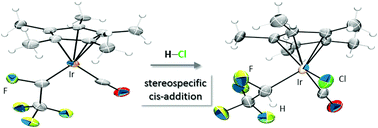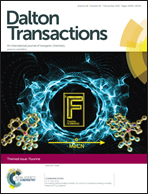Synthesis, structure, and reactivity of iridium perfluorocarbene complexes: regio- and stereo-specific addition of HCl across a metal carbon double bond†
Abstract
Reductive activation of an α-fluorine in the perfluoroalkyl complexes Cp*(L)(I)Ir–CF2RF using Mg/graphite leads to perfluorocarbene complexes Cp*(L)Ir![[double bond, length as m-dash]](https://www.rsc.org/images/entities/char_e001.gif) CFRF (L = CO, PMe3; RF = CF3, C2F5, C6F5). New complexes E-Cp*(PMe3)Ir
CFRF (L = CO, PMe3; RF = CF3, C2F5, C6F5). New complexes E-Cp*(PMe3)Ir![[double bond, length as m-dash]](https://www.rsc.org/images/entities/char_e001.gif) CFC2F5 and E-Cp*(CO)Ir
CFC2F5 and E-Cp*(CO)Ir![[double bond, length as m-dash]](https://www.rsc.org/images/entities/char_e001.gif) CFC6F5 have been characterized by single crystal X-ray diffraction studies, and a comparison of metric parameters with previously reported analogues is reported. Experimental NMR and computational DFT (B3LYP/LACV3P**++) studies agree that for Ir
CFC6F5 have been characterized by single crystal X-ray diffraction studies, and a comparison of metric parameters with previously reported analogues is reported. Experimental NMR and computational DFT (B3LYP/LACV3P**++) studies agree that for Ir![[double bond, length as m-dash]](https://www.rsc.org/images/entities/char_e001.gif) CFRF complexes (RF = CF3, CF2CF3) the thermodynamic preference for the E or Z isomer depends on the steric requirements of ligand L; when L = CO the Z-isomer (F cis to Cp*) is preferred and for L = PMe3 the E-isomer is preferred. When reduction of the precursors is carried out in the dark the reaction is completely selective to produce E- or Z-isomers. Exposure of solutions of these compounds to ambient light results in slow conversion to a photostationary non-equilibrium mixture of E and Z isomers. In the dark, these E/Z mixtures convert thermally to their preferred E or Z equilibrium geometries in an even slower reaction. A study of the temperature dependent kinetics of this dark transformation allows ΔG‡298 for rotation about the Ir
CFRF complexes (RF = CF3, CF2CF3) the thermodynamic preference for the E or Z isomer depends on the steric requirements of ligand L; when L = CO the Z-isomer (F cis to Cp*) is preferred and for L = PMe3 the E-isomer is preferred. When reduction of the precursors is carried out in the dark the reaction is completely selective to produce E- or Z-isomers. Exposure of solutions of these compounds to ambient light results in slow conversion to a photostationary non-equilibrium mixture of E and Z isomers. In the dark, these E/Z mixtures convert thermally to their preferred E or Z equilibrium geometries in an even slower reaction. A study of the temperature dependent kinetics of this dark transformation allows ΔG‡298 for rotation about the Ir![[double bond, length as m-dash]](https://www.rsc.org/images/entities/char_e001.gif) CFCF3 double bond to be experimentally determined as 25 kcal mol−1; a DFT/B3LYP/LACV3P**++ calculation of this rotation barrier is in excellent agreement (27 kcal mol−1) with the experimental value. Reaction of HCl with toluene solutions of Cp*(L)Ir
CFCF3 double bond to be experimentally determined as 25 kcal mol−1; a DFT/B3LYP/LACV3P**++ calculation of this rotation barrier is in excellent agreement (27 kcal mol−1) with the experimental value. Reaction of HCl with toluene solutions of Cp*(L)Ir![[double bond, length as m-dash]](https://www.rsc.org/images/entities/char_e001.gif) CFRF (L = CO, PMe3) or Cp*(CO)Ir
CFRF (L = CO, PMe3) or Cp*(CO)Ir![[double bond, length as m-dash]](https://www.rsc.org/images/entities/char_e001.gif) C(CF3)2 at low temperature resulted in regiospecific addition of HCl across the metal carbon double bond, ultimately yielding Cp*(L)Ir(CHFRF)Cl and Cp*(CO)Ir[CH(CF3)2]Cl. Reaction of HCl with single E or Z diastereomers of Cp*(L)Ir
C(CF3)2 at low temperature resulted in regiospecific addition of HCl across the metal carbon double bond, ultimately yielding Cp*(L)Ir(CHFRF)Cl and Cp*(CO)Ir[CH(CF3)2]Cl. Reaction of HCl with single E or Z diastereomers of Cp*(L)Ir![[double bond, length as m-dash]](https://www.rsc.org/images/entities/char_e001.gif) CFRF gives stereospecific cis-addition to give single diastereomers of Cp*Ir(L)(CHFRF)Cl; addition of HCl to several different E/Z ratios of Cp*(L)Ir
CFRF gives stereospecific cis-addition to give single diastereomers of Cp*Ir(L)(CHFRF)Cl; addition of HCl to several different E/Z ratios of Cp*(L)Ir![[double bond, length as m-dash]](https://www.rsc.org/images/entities/char_e001.gif) CFRF affords ratios of diastereomeric products Cp*(L)Ir(CHFRF)Cl identical to the original ratio of starting material isomers. The addition of HCl is therefore demonstrated to be unambiguously regio- and stereo-specific. The observed product regiochemistry of addition of HCl to Ir
CFRF affords ratios of diastereomeric products Cp*(L)Ir(CHFRF)Cl identical to the original ratio of starting material isomers. The addition of HCl is therefore demonstrated to be unambiguously regio- and stereo-specific. The observed product regiochemistry of addition of HCl to Ir![[double bond, length as m-dash]](https://www.rsc.org/images/entities/char_e001.gif) CF2, Ir
CF2, Ir![[double bond, length as m-dash]](https://www.rsc.org/images/entities/char_e001.gif) CFRF, and Ir
CFRF, and Ir![[double bond, length as m-dash]](https://www.rsc.org/images/entities/char_e001.gif) C(CF3)2 ligands is the same and is not dependent on the ground state energy preference (singlet or triplet) for the free perfluorocarbene. DFT calculations on model HCl addition reactions indicate that this regiochemistry is strongly preferred thermodynamically, but predict that in Hδ+–Clδ− addition to Cp(PH3)Ir
C(CF3)2 ligands is the same and is not dependent on the ground state energy preference (singlet or triplet) for the free perfluorocarbene. DFT calculations on model HCl addition reactions indicate that this regiochemistry is strongly preferred thermodynamically, but predict that in Hδ+–Clδ− addition to Cp(PH3)Ir![[double bond, length as m-dash]](https://www.rsc.org/images/entities/char_e001.gif) CF2, Hδ+ attack at Ir has a lower energy transition state, while for Cp(PH3)Ir
CF2, Hδ+ attack at Ir has a lower energy transition state, while for Cp(PH3)Ir![[double bond, length as m-dash]](https://www.rsc.org/images/entities/char_e001.gif) CFCF3 and Cp(PH3)Ir
CFCF3 and Cp(PH3)Ir![[double bond, length as m-dash]](https://www.rsc.org/images/entities/char_e001.gif) C(CF3)2, Hδ+ attack at C is the kinetically preferred pathway. The carbene carbon atoms in Ir
C(CF3)2, Hδ+ attack at C is the kinetically preferred pathway. The carbene carbon atoms in Ir![[double bond, length as m-dash]](https://www.rsc.org/images/entities/char_e001.gif) CFCF3 and Ir
CFCF3 and Ir![[double bond, length as m-dash]](https://www.rsc.org/images/entities/char_e001.gif) C(CF3)2 complexes are unambiguously basic towards HCl, while in the Ir
C(CF3)2 complexes are unambiguously basic towards HCl, while in the Ir![[double bond, length as m-dash]](https://www.rsc.org/images/entities/char_e001.gif) CF2 analogues the carbene carbon is less basic than its Ir partner, and the eventual regiochemistry of HCl addition arises from thermodynamic control.
CF2 analogues the carbene carbon is less basic than its Ir partner, and the eventual regiochemistry of HCl addition arises from thermodynamic control.

- This article is part of the themed collection: Fluorine

 Please wait while we load your content...
Please wait while we load your content...